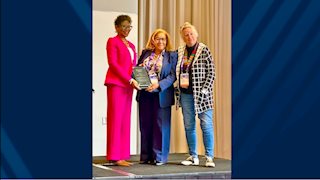MORGANTOWN, W.Va. – After his long flight over the Atlantic landed in Washington D.C., Oleh Bodilovskyi knew exactly where he wanted to go.
“I’m an engineer, and the first place I went was the National Air and Space Museum in Washington,” Bodilovskyi said. “I saw the moon landing module right there, so I took a selfie.”
After his photo with the Apollo Lunar Module #2, Bodilovskyi’s next stop was a bus trip to Morgantown, where he is the first student from the National Technical University of Ukraine “Kyiv Polytechnic Institute” (NTUU “KPI”) to visit the West Virginia University Health Sciences Center through the memorandum of understanding between the two universities that took effect this January.
Bodilovskyi will spend the next six months continuing his Ph.D. research at the WVU Center for Neuroscience under the direction of Sergiy Yakovenko, Ph.D., assistant professor of exercise physiology and neuroscience at the WVU School of Medicine.
At WVU, Bodilovskyi will contribute to the development of control systems for a prosthetic limb. The WVU team is using neuromechanical models of complex human movement to design controls for the prosthesis that help it to respond like a real limb would.
“I expect that Oleh will make a substantial contribution to the development of control components for prosthetic limbs,” Yakovenko said. “His engineering background in wearable sensors and signal analysis from KPI in Kyiv will make him a valuable member of our team with a unique set of skills that we need.”
Bodilovskyi came to WVU to take advantage of the existing relationship between the two universities. He met Yakovenko at the KPI Summer School, where Yakovenko has been an instructor for the last two years and began collaborating with Bodilovskyi’s supervisor at KPI. Bodilovskyi expects the recent memorandum of understanding to be a benefit to both schools.
 “In Ukraine, we have a lot of engineers with good skills, with modeling skills,” Bodilovskyi said. “Math, physics, all this stuff Ukrainian students can do, but here in the United States, you have equipment, you have grants, you have connections between education and industry. So we can develop some good stuff together.”
“In Ukraine, we have a lot of engineers with good skills, with modeling skills,” Bodilovskyi said. “Math, physics, all this stuff Ukrainian students can do, but here in the United States, you have equipment, you have grants, you have connections between education and industry. So we can develop some good stuff together.”
Now in his fourth and final year of Ph.D. work, Bodilovskyi is developing a system that uses cameras to measure respiratory parameters, such as respiration rate and inhale-to-exhale ratio. These devices are for non-contact applications, which are situations when it is inadvisable to attach a physical monitor, such as driving a car, flying a plane or caring for neonatal infants. He will defend his thesis when he returns to Ukraine in the fall, and then find a place to use his skills — possibly returning to WVU.
Yakovenko, for one, is pleased to see the relationship between WVU and KPI growing.
“I am hoping that the Memorandum of Understanding between KPI and WVU will help us create productive connections with talented scientists and engineers in Ukraine over the next five years, and Oleh is spearheading this effort.”
PHOTO: Oleh Bodilovskyi poses with the Lunar Module #2, modified to look like the Apollo 11 “Eagle” module used for the original moon landing, on display at the Smithsonian National Air and Space Museum.
PHOTO: (L to R) Anton Sobinov, a first-year Ph.D. student in neuroscience; Oleh Bodilovskyi; Matthew Boots, a second-year Ph.D. student in mechanical and aerospace engineering; and Sergiy Yakovenko, Ph.D., study an electronic model of the human arm.

